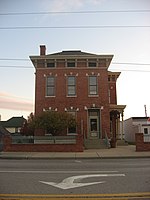Saint John the Evangelist Catholic Church is a Roman Catholic parish of the Archdiocese of Indianapolis in Indianapolis, Indiana, United States. The parish's origins date to 1837, when it was first named Holy Cross parish. In 1850 it was renamed Saint John the Evangelist parish, and is the oldest Catholic parish in the city and in Marion County, Indiana. Considered the mother of the Catholic parishes in Indianapolis, it played an important role in development of the Catholic Church in the city. Saint John's Church served as the pro-cathedral of the diocese from 1878 until 1906; its rectory served as the bishop's residence and chancery from 1878 until 1892. In 1900 the church served as the site of first episcopal consecration held in Indianapolis.
Although many considered Saint John's a diocesan cathedral, it was never officially named as such. Saint Francis Xavier Cathedral remained the official cathedral and Vincennes, Indiana, as the see city for the Roman Catholic Diocese of Vincennes, Indiana, until March 28, 1898, when the episcopal see was transferred to Indianapolis and became the Diocese of Indianapolis. Diocesan functions continued to be held at Saint John's until Saints Peter and Paul Cathedral was built in 1906. Saint John's rectory continued to house the diocesan chancery until 1968, and served as the metropolitan tribunal for the diocese until 1982. Saint John's Church and rectory were placed on the National Register of Historic Places in 1980.
The present-day Saint John's Church, the parish's third and the second one built on the Georgia Street property, is the main structure in a group of parish buildings on the southwest corner of Georgia Street and Capitol Avenue. Diedrich A. Bohlen, principal and founder of the Indianapolis architectural firm of D. A. Bohlen and Son, designed the rectory (1863), church (1867–71), and a rectory addition (1878). Bohlen's son, Oscar, designed the twin spires and supervised their construction in 1893. The red-brick church has an eclectic style, including elements of French Gothic Revival and American Romanesque Revival architecture. The sanctuary has a seating capacity of 3,000. It was the largest church in Indiana when the cornerstone was laid in 1867; it was dedicated on July 2, 1871.









